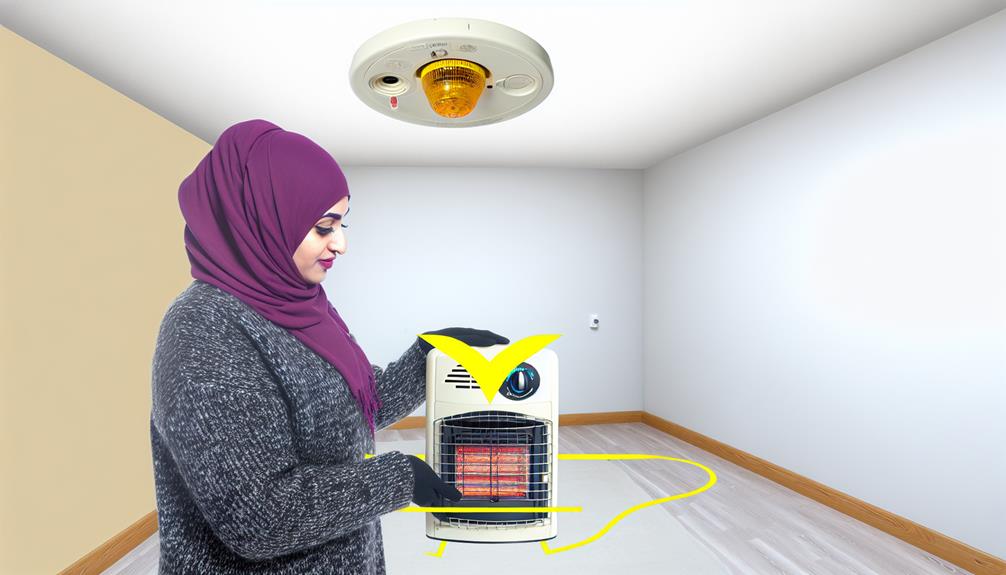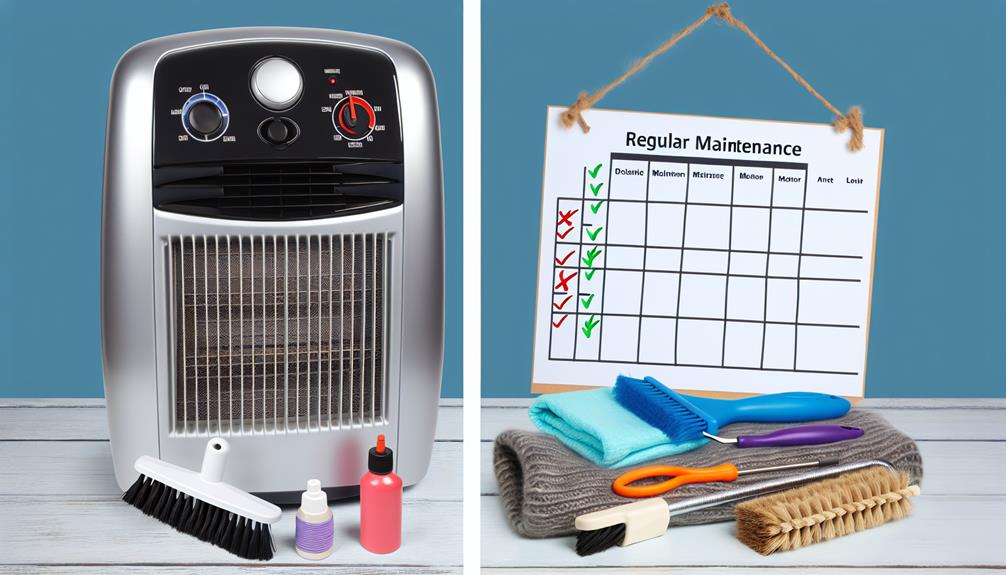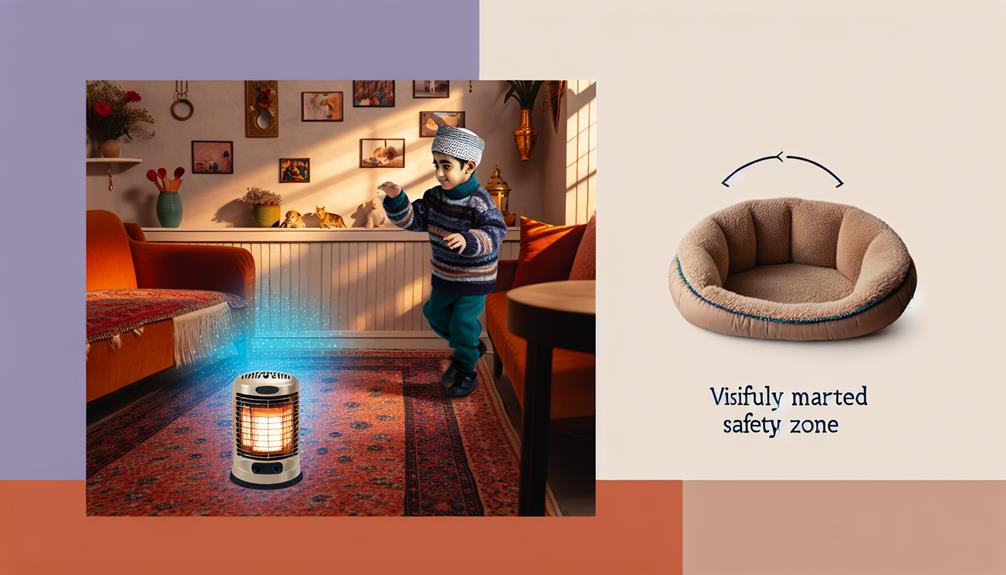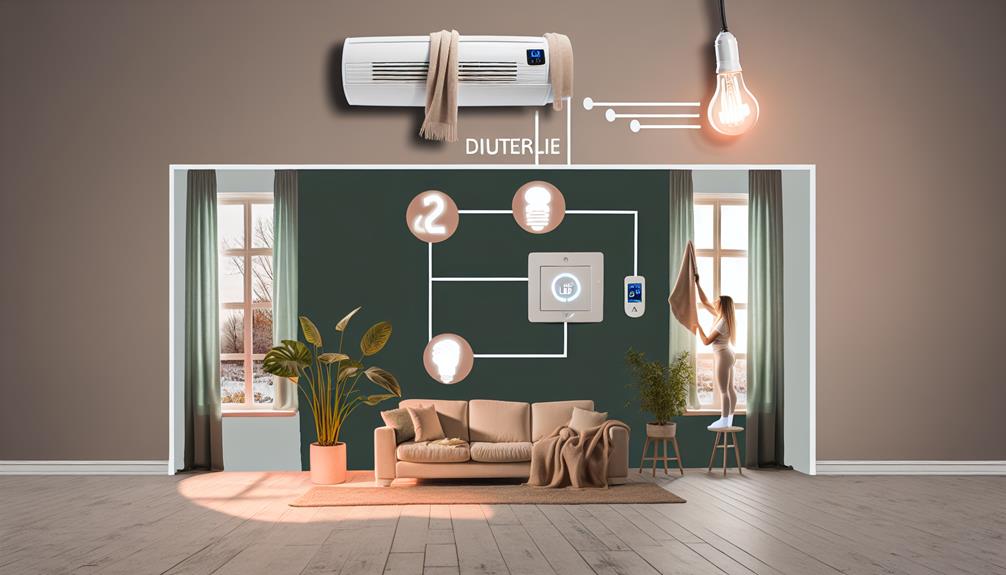As you navigate the chilly corridors of your home during the winter months, a portable heater can be a warm companion, as comforting as a cup of cocoa on a snowy day. However, it's crucial that you understand the do's and don'ts of its operation to ensure your safety and maximize efficiency. You wouldn't want to treat this device as an 'out of sight, out of mind' appliance; there are specific guidelines you should follow, from choosing the right model to its placement and maintenance. While you're likely familiar with the basics—like not covering the heater or plugging it into a power strip—there are finer points that often go unnoticed, yet can make all the difference in preventing a mishap. Stick around, and let's explore the essential safety features to look for before making a purchase, and the subtle yet vital practices that can protect you, your loved ones, and your home from unintended consequences.
Key Takeaways
- Choose a heater with safety certifications and automatic shut-off capabilities.
- Follow proper heater placement guidelines, including keeping the heater at least three feet away from flammable materials and anything that can burn.
- Perform regular maintenance checks and inspections for signs of wear or damage to the power cord.
- Ensure adequate ventilation to prevent carbon monoxide buildup and avoid obstructing the heater's air intake or exhaust.
Choosing the Right Heater
When selecting a space heater, it's crucial to opt for a model with UL or ETL safety certifications to ensure it adheres to established safety guidelines. The safety certification label is your assurance that the product has been rigorously tested and meets the stringent standards set by organizations such as the Underwriters Laboratories (UL) or Intertek (ETL). This is your first step in ensuring space heater safety.
Portable space heaters come with various features that enhance their safe operation. Look for models with automatic shut-off capabilities, which trigger when the device overheats or tips over. These critical safety features significantly minimize the risk of fire hazards, helping to protect you and your home.
It's also important to select a heater that's well-suited to the room size. The Association of Home Appliance Manufacturers suggests choosing a unit that provides adequate heating without wasting energy. Overpowering a small space with a large heater, or vice versa, can be inefficient and unsafe.
Lastly, always plug your space heater directly into a wall outlet, never into an extension cord or power strip, to prevent overheating. Position the heater on a level surface, away from flammable materials, maintaining a safe distance of at least three feet. This precaution ensures the heating element operates under optimal conditions, safeguarding your safety and comfort.
Proper Heater Placement
Ensuring your portable heater sits on a stable, level surface is essential to prevent it from tipping over and causing accidents. Proper heater placement isn't just about convenience; it's a critical aspect of home safety. To keep your household safe and warm, you'll want to follow a few key guidelines:
- Stable Surface: Always place your heater on a solid, stable surface, avoiding any potential wobbles that could lead to mishaps.
- Distance Matters: Keep the unit at least three feet away from anything that can burn, including papers, clothing, and curtains.
- Safety Features: Choose heaters with safety features like automatic shutoffs in case they tip over or overheat.
- Clear Pathways: Make sure the heater is not in a high-traffic area to avoid tripping, and don't run cords under rugs or furniture.
Safe Operation Practices

As you use your portable heater, it's crucial to follow heater placement guidelines, ensuring it's on a stable surface away from flammable materials. You must perform regular maintenance checks for any signs of wear or damage to the power cord, which could pose a fire risk. Additionally, always ensure your heater has adequate ventilation to prevent carbon monoxide buildup and maintain air quality.
Heater Placement Guidelines
To minimize fire risks and ensure safe operation, always position your space heater at least three feet away from any flammable materials. Following heater placement guidelines isn't just about compliance; it's about your safety.
Here are four crucial points to remember:
- Place your heater on a flat, stable surface to prevent it from tipping over.
- Avoid placing your heater near electrical outlets or cords, reducing electrical hazards.
- Ensure the heater is out of reach of children and pets to avoid accidents.
- Never use surge protectors with space heaters; plug them directly into the wall outlet.
Be vigilant and cautious with these guidelines to maintain a warm, secure, and fire-free environment.
Regular Maintenance Checks
Regular maintenance checks are crucial for the safe operation of your portable heater, helping to prevent potential hazards and extend the unit's lifespan. Consistently inspect the power cord for signs of wear or damage; frayed wires or loose connections can overheat and cause a risk of fire. When you're not using the heater, always turn it off and unplug it, especially before sleeping, to minimize any danger. It's vital to place space heaters on a flat, stable surface to prevent them from tipping over. Moreover, never run the power cord under rugs, carpets, or furniture, as this not only poses a fire hazard but can also impede safety. Vigilance in these practices assures that you're using your space heaters responsibly and safely.
Adequate Ventilation Importance
Ensuring your portable heater operates in a well-ventilated space is essential to prevent the accumulation of dangerous gases and maintain healthy air quality. Here are some safety tips that highlight the importance of proper ventilation:
- Place the Heater Properly: Never obstruct the space heater's air intake or exhaust; it's crucial for preventing overheating and reducing fire risk.
- Check for Damage: Inspect the power cord for wear or damage that could lead to electrical hazards.
- Select Safe Features: Opt for heaters with a cool-touch exterior and automatic shut-off to enhance safety.
- Avoid Damp Spaces: Keep the space heater out of wet areas to prevent electrical shocks and accidents.
Maintenance and Upkeep

Inspect your portable heater's power cord regularly for damage to maintain safe operation and prevent hazards. Over time, cords can fray or become worn, posing serious risks. Establish a routine to check for any signs of distress on the cord and plug, and if you spot any, discontinue use and replace or repair the heater.
For optimal maintenance and upkeep, adhere closely to the manufacturer's instructions. Space heaters vary in design and functionality, and the guidelines ensure you're using the heater as intended, reducing the likelihood of malfunctions. It's also wise to choose models with safety features like tip-over switches, which automatically shut off the heater if it falls over, and overheating sensors that prevent it from getting too hot.
Keep space heaters at least three feet away from anything flammable. This buffer zone is crucial in minimizing fire risks. Remember to turn off and unplug your heater when it's not in use, especially before bedtime. This not only conserves energy but also eliminates a common source of home fires.
Recognizing Hazard Signs
Stay alert for the danger sign of a hot power cord on your space heater, as it's a clear indicator of overheating and requires immediate action. This is one of the critical signs you must never ignore, as it can lead to fires caused by a faulty heat source. When you're using a portable heater, it's vital to recognize hazard signs that could put you and your home at risk.
Here's what you should look out for:
- Hot power cord: If it's too hot to touch, unplug it immediately.
- Damaged elements: Cracked or frayed cords, damaged prongs, or loose connections mean it's time to replace the unit.
- Wear and tear: Regularly inspect your heater for signs of damage or deterioration.
- Test alarms: Ensure smoke and carbon monoxide alarms are working properly.
Child and Pet Safety

When using portable heaters, you must prioritize the safety of your children and pets. Always secure the heater's placement to prevent tipping, and use barriers when necessary, while ensuring airflow isn't obstructed. It's crucial to supervise their interaction with heaters and invest in models with advanced safety features.
Secure Heater Placement
To ensure the safety of your little ones and furry companions, it's crucial to place portable heaters out of their reach, thereby reducing the risk of accidental burns or tipping. When considering secure heater placement, keep these guidelines in mind:
- Elevate the Space Heater: Position it at a height where it's inaccessible to children and pets.
- Install Barriers: Use safety gates to maintain a safe distance while ensuring proper airflow.
- Maintain Distance: Keep the heater at least three feet away from bedding, curtains, and furniture.
- Direct Connection: Always plug your heater directly into a wall outlet, avoiding extension cords or power strips which can pose additional hazards.
Supervision Guidelines
Always supervise children and pets when a portable heater is in use to prevent accidents and ensure their safety. Space heaters are responsible for providing warmth, but without proper supervision guidelines, they can pose serious fire safety risks. Never leave a heater unattended in the presence of children or pets; accidents can happen swiftly and with dire consequences.
Here's a quick guide:
| Action | Child Safety | Pet Safety |
|---|---|---|
| Elevate Heater | Prevents touching/burns | Prevents knocking over |
| Use Barriers | Limits access | Keeps pets at a safe distance |
| Out of Reach | Ensures they can't interfere | Reduces burn risk |
Safety Feature Essentials
Ensure your portable heater is equipped with essential safety features that protect both children and pets from potential harm. According to the National Fire Protection Association, space heaters come with risks, and without proper usage, they can cause a fire. Here are safety feature essentials to look for:
- Automatic Shut-off: A heater should turn off automatically if tipped over.
- Cool-to-Touch Exterior: Prevents burns upon accidental contact.
- Thermostat Control: Maintains a safe temperature to avoid overheating.
- Protective Grills: Bars that are close enough to prevent small fingers or paws from reaching inside.
Always be cautious with space heaters to ensure they don't become a fire hazard in your home.
Energy Efficiency Tips

While selecting a space heater, opt for models with energy-efficient features to reduce power consumption and lower your utility bills. Modern space heaters come with various functionalities aimed at optimizing energy use. Look for heaters with programmable thermostats or timers that allow you to control the heating schedule, ensuring that you're only using energy when it's needed.
Be cautious in your choice, considering models that come with safety certification labels from independent testing organizations. These not only guarantee the safe operation of your portable heater but also tend to be more energy-efficient. Directly plug your heater into the wall outlet to prevent overheating and potential fire hazards associated with surge protectors.
Maintain your heating equipment by regularly inspecting for damage or malfunction. Follow the manufacturer's guidelines for proper use and maintenance to keep the heater running at peak efficiency. Remember, a well-maintained portable heater will not only be safer but can also save energy.
Moreover, installing and testing smoke and carbon monoxide alarms monthly contributes to a safe home heating system. These precautions, along with adhering to energy efficiency tips, ensure that your heating is both cost-effective and secure.
When to Replace Heaters
Consider replacing your space heater if it has received a 'Poor' rating in fire safety tests or shows any signs of wear and damage. Your space heater, much like any other appliance, has a lifespan and for your safety, it's critical to know when it's time for it to retire. Here's a quick guide to help you determine if it's time to shop for a new heater:
- Safety Ratings: If your heater has failed to meet standards set by the Consumer Product Safety Commission or an independent testing organization, don't hesitate to replace it.
- Physical Condition: Inspect your heater for a cracked or frayed cord, damaged prongs, or loose connections. Any of these issues can pose a significant fire hazard.
- Overheating: If your heater feels unusually hot or overheats, it's a clear sign that it's struggling to operate safely and efficiently. This could indicate an internal fault that warrants immediate replacement.
- Lack of Safety Features: Modern heaters, endorsed by the Association of Home Appliance Manufacturers, include safety features like automatic shut-off. If yours is lacking these, it's time to consider an upgrade.
Don't ignore these warning signs; keeping an outdated or malfunctioning space heater could put you at risk.
Frequently Asked Questions
How Do You Use a Portable Heater Safely?
To stay cozy without getting burned, remember heater placement is key; keep it clear from flammables. Ventilation importance can't be overstated—fresh air avoids hazards. Regular maintenance checks ensure your heater's not a silent threat. Cord safety is crucial; keep them away from foot traffic. Lastly, adjust thermostat settings to a safe level. You'll be warm and secure, steering clear of danger with these mindful steps.
Is It OK to Leave Portable Heater on All Night?
No, it's not safe to leave your portable heater on all night. You're risking fire hazards, excessive energy consumption, and potential carbon monoxide poisoning. Moreover, the heater can cause sleep disturbances. Always turn it off before bed to protect yourself and your home. Remember, safety should be your top priority; don't compromise it for the sake of a little extra warmth. Keep vigilant and ensure a secure environment overnight.
What Precautions Should Be Taken When Using a Room Heater?
When using a room heater, you must minimize fire risks by ensuring proper heater placement, away from flammables. Regular maintenance checks are crucial to prevent hazards. Don't overlook ventilation importance; it guards against carbon monoxide build-up. Always keep your space heater on a stable surface and directly plugged into an outlet. Remember, your safety is paramount, so follow these precautions diligently to keep warm without risking your well-being.
What Are the Side Effects of Portable Heaters?
You might not realize it, but your cozy portable heater can cause dry air and aggravate allergies. It's a fire hazard if mishandled and boosts energy consumption significantly. Inadequate ventilation can lead to dangerous carbon monoxide buildup. Remember, safety first—check for damage regularly and use your heater responsibly to avoid these side effects. Keep your space warm, but also ensure it's safe and healthy.
